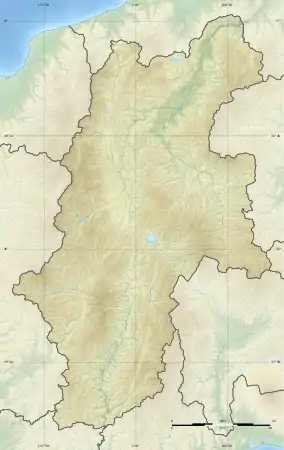Ōmiyama ruins
Ōmiyama ruins (大深山遺跡, Ōmiyama iseki) is an archaeological site containing the ruins of a mid Jōmon period (2500–1500 BCE) settlement located in what is now part of the village of Kawakami, Nagano in the Chūbu region of Japan. The site was designated a National Historic Site of Japan in 1966.[1]
大深山遺跡 | |
 Ōmiyama ruins  Ōmiyama ruins (Japan) | |
| Location | Kawakami, Nagano, Japan |
|---|---|
| Region | Chūbu region |
| Coordinates | 35°58′39″N 138°33′56″E |
| Type | settlement |
| History | |
| Periods | Jōmon period |
| Site notes | |
| Ownership | National Historic Site |
| Public access | None |
Overview
The site is located on a plateau on the southeastern slope of Mount Yatsugatake at an altitude of 1300 meters, near the right bank of the headwaters of the Chikuma River. It is the highest of the Jōmon period ruins yet discovered around Mount Yatsugatake and one of the highest in Japan. It was excavated from 1953, during which time a dense concentration of over 50 pit dwellings, paving stones and tens of thousands of pottery and stoneware shards were found.
Currently, the site has two reconstructed pit houses and the Kawakami Village Cultural Center has a small collection of some of the artifacts found, including human-shaped pottery.
The site is approximately 15 minutes by car from Shinano-Kawakami Station.
References
- "大深山遺跡跡" (in Japanese). Agency for Cultural Affairs.
External links
- Kawakami Village official site (in Japanese)